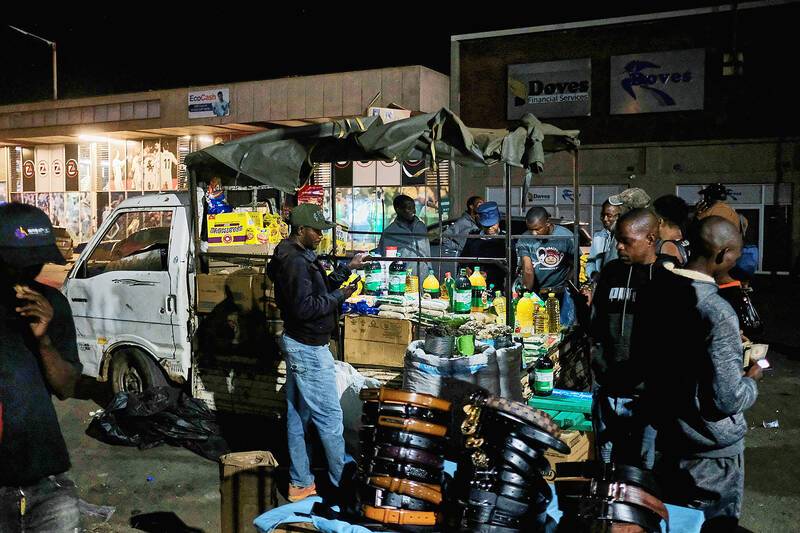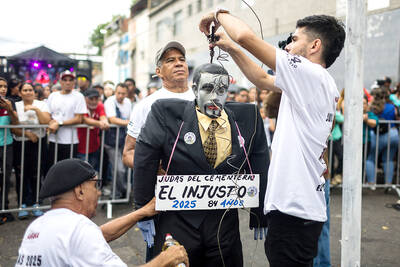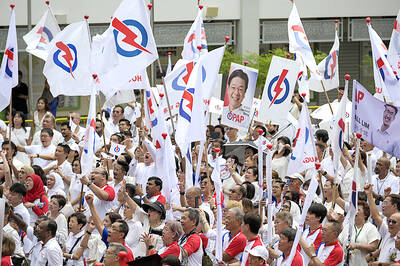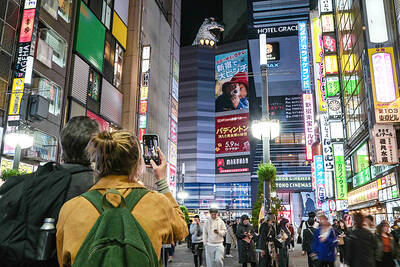After the sun sets in Harare, the streets of Zimbabwe’s capital suddenly burst to life. Carts, cars and trucks turned into makeshift, unauthorized shops sell anything from potatoes to babies’ diapers on the pavements of the city center.
Shopping is best done at night in times of hyperinflation and economic hardship. Cash-crunched Zimbabweans are increasingly turning to informal vendors for their groceries shopping, as, with little or no overheads, street hawkers can afford to undercut big supermarkets.
“Everything is always cheaper outside,” Blessing Steven, 23, a taxi driver, said, buying a bottle of juice for US$0.50 at a roadside stall rather than in a supermarket where it costs US$1. “I save money.”

Photo: AFP
The juice vendor, Shingirirai Goriondo, 23, said that he gets more customers than the retail outlet he operates in front of.
“All beverages I sell here are being charged double there,” he said, pointing to a branch of supermarket chain Foodworld.
Inflation has shot through the roof in recent weeks as Zimbabwe prepares for presidential and parliamentary elections in August.
Officially standing at more than 280 percent last month, analysts estimate the inflation rate is in fact somewhere more than 700 percent.
Economists blame the crisis on a steep depreciation of the local currency on the black market — where most trading takes place.
Only last month, the Zimbabwean dollar was trading at about 1,000 against its more coveted US counterpart.
Today, one greenback costs between 3,800 and 4,000 Zimbabwean dollars on the street — although the official rate is 1,888.
The situation has created price madness in supermarkets. Agence France-Presse reporters have in recent days observed staff changing price tags on goods every morning to try to keep pace with the exchange rate.
This has brought back memories of 2008, when hyperinflation was so out of control that restaurant-goers would see the price of their dinner change before they could finish eating it. Back then, the central bank even issued a 100-trillion-dollar note — now a collectors’ item.
The government was eventually forced to ditch the local currency and adopt the US dollar as legal tender. The Zimbabwean dollar was revived in 2019, but it seems to be suffering from much the same ailments as its previous incarnation.
Most Zimbabweans prefer to do business, get paid and hold their savings in US dollars. Many who earn a salary in local money rush to currency exchange shops on pay day.
“It is now expensive to purchase groceries from the supermarket with our own currency,” said Tarisai Bera, 36, buying a range of toiletries from a hawker.
Curbside shops take only greenbacks and prices there “rarely change,” Bera said.
Street trade gets busier after dark, because there is less police to go around. Most hawkers are not allowed to operate.
“If we come earlier ...we might end up having our goods confiscated and fined,” said Julius Munyanyi, 46, a vendor.
The government has resorted to various expedients to stabilize the economy, including issuing gold coins and launching a gold-backed digital currency — but so far to no avail. The central bank’s main interest rate is currently at 140 percent.
Former Zimbabwean minister of finance Tendai Biti, now an opposition politician, has blamed Zimbabwean Minister of Finance Mthuli Ncube for much of the chaos.
“Treasury, the natural gate keeper has become the gate crasher,” Biti wrote on Twitter last week.
Zimbabwean President Emmerson Mnangagwa has instead pointed the finger at US dollar-loving businesses.
“Zimbabwe dollar-earning workers are now being forced to buy basics priced exclusively in foreign currency,” Mnangagwa wrote in a weekly newspaper column earlier this month.
Whatever the reason, business is thriving for street traders like Munyanyi.
“Customers find it viable to buy from us. We literally don’t have competition,” he said.

POLITICAL PRISONERS VS DEPORTEES: Venezuela’s prosecutor’s office slammed the call by El Salvador’s leader, accusing him of crimes against humanity Salvadoran President Nayib Bukele on Sunday proposed carrying out a prisoner swap with Venezuela, suggesting he would exchange Venezuelan deportees from the US his government has kept imprisoned for what he called “political prisoners” in Venezuela. In a post on X, directed at Venezuelan President Nicolas Maduro, Bukele listed off a number of family members of high-level opposition figures in Venezuela, journalists and activists detained during the South American government’s electoral crackdown last year. “The only reason they are imprisoned is for having opposed you and your electoral fraud,” he wrote to Maduro. “However, I want to propose a humanitarian agreement that

ECONOMIC WORRIES: The ruling PAP faces voters amid concerns that the city-state faces the possibility of a recession and job losses amid Washington’s tariffs Singapore yesterday finalized contestants for its general election on Saturday next week, with the ruling People’s Action Party (PAP) fielding 32 new candidates in the biggest refresh of the party that has ruled the city-state since independence in 1965. The move follows a pledge by Singaporean Prime Minister Lawrence Wong (黃循財), who took office last year and assumed the PAP leadership, to “bring in new blood, new ideas and new energy” to steer the country of 6 million people. His latest shake-up beats that of predecessors Lee Hsien Loong (李顯龍) and Goh Chok Tong (吳作棟), who replaced 24 and 11 politicians respectively

Young women standing idly around a park in Tokyo’s west suggest that a giant statue of Godzilla is not the only attraction for a record number of foreign tourists. Their faces lit by the cold glow of their phones, the women lining Okubo Park are evidence that sex tourism has developed as a dark flipside to the bustling Kabukicho nightlife district. Increasing numbers of foreign men are flocking to the area after seeing videos on social media. One of the women said that the area near Kabukicho, where Godzilla rumbles and belches smoke atop a cinema, has become a “real

‘WATER WARFARE’: A Pakistani official called India’s suspension of a 65-year-old treaty on the sharing of waters from the Indus River ‘a cowardly, illegal move’ Pakistan yesterday canceled visas for Indian nationals, closed its airspace for all Indian-owned or operated airlines, and suspended all trade with India, including to and from any third country. The retaliatory measures follow India’s decision to suspend visas for Pakistani nationals in the aftermath of a deadly attack by shooters in Kashmir that killed 26 people, mostly tourists. The rare attack on civilians shocked and outraged India and prompted calls for action against their country’s archenemy, Pakistan. New Delhi did not publicly produce evidence connecting the attack to its neighbor, but said it had “cross-border” links to Pakistan. Pakistan denied any connection to